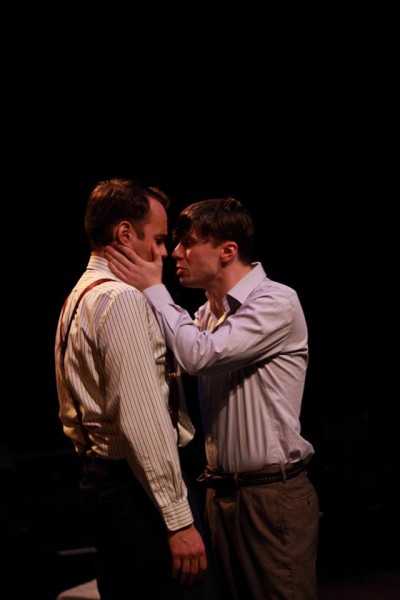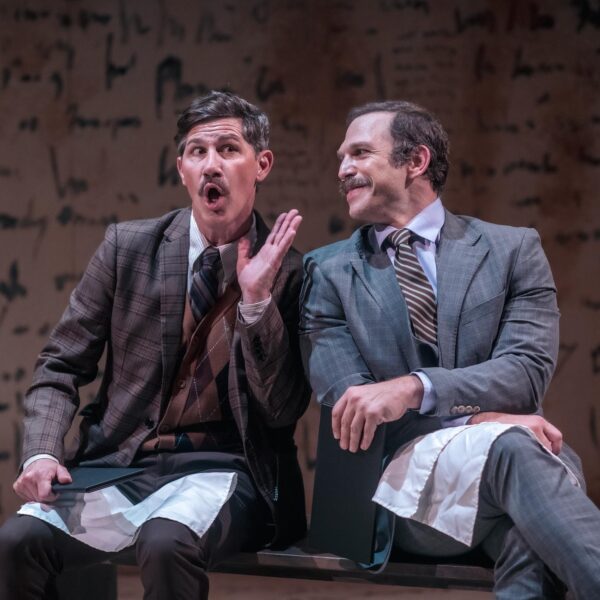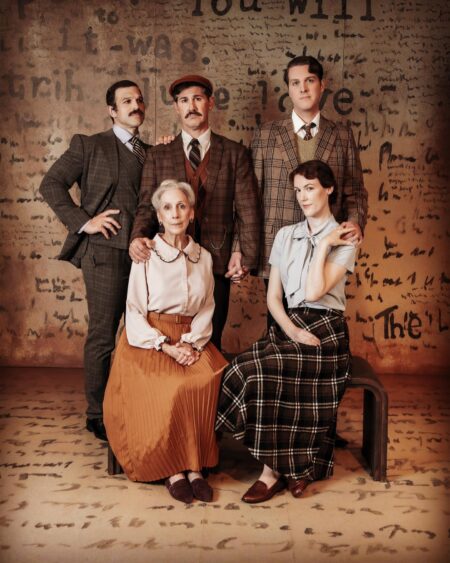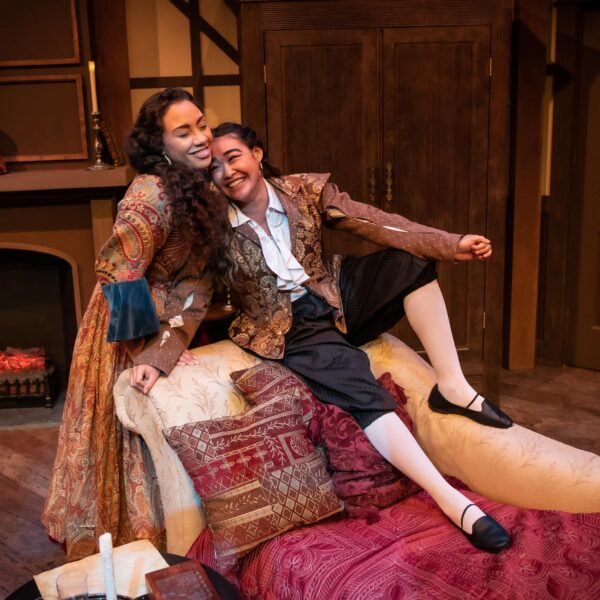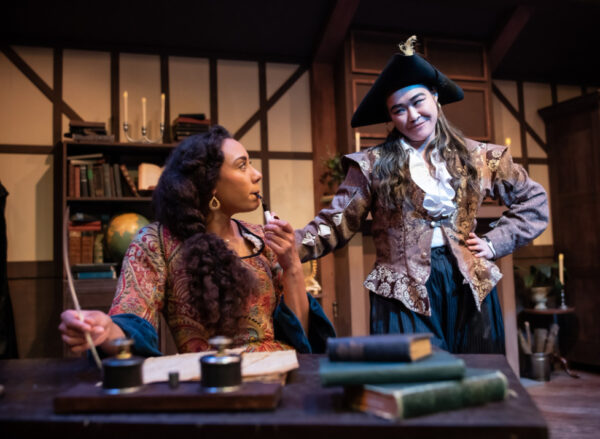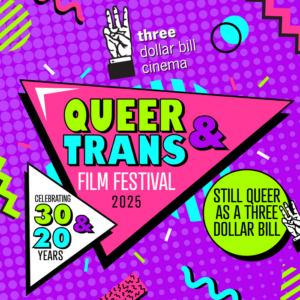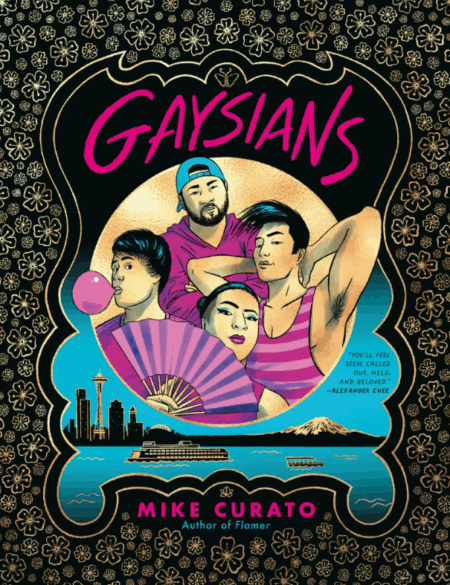I WILL catch up on my theater reviews…after a week of snit fits and high drama, let’s look at three current productions on hand at Seattle theater companies.
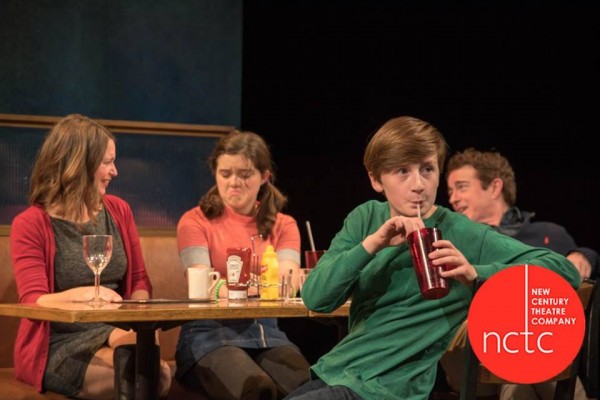
The nuclear family in New Century Theatre Company’s THE BIG MEAL…. Betsy Schwartz, Maire Kennan, Julian Mudge-Burns, Darragh Kennan. Photo: Christopher Monsos
Review: The Big Meal by Dan LeFranc. Produced by New Century Theatre Company. Directed by Makaela Pollock. Scenic Design by Carol Wolfe Clay. Lighting Design by Andrew D. Smith. Costume Design by Pete Rush. Sound Design by Johanna Melamed. Props Design by Robin Mccartney. With Jonelle Jordan, Darragh Kennan, Maire Kennan, Todd Jefferson Moore, Hannah Mootz, Julian Mudge-Burns, Conner Neddersen, Betsy Schwartz, Amy Thone. Now through November 19, 2016 at 12th Avenue Arts.
New Century Theatre Company is staging the area premiere of Dan LeFranc’s time smooshed/multi-generational family drama THE BIG MEAL where five generations of a family’s life are examined in about 90 minutes. Eight actors (two kids and six adults split between male/female) portray…I lost count. About a dozen different characters at various stages in their lives with the entire story relayed over a series of meals taken together. Mr. LeFranc’s rather obvious metaphor for life is…it’s a Big Meal. Or, a series of meals with the “Big” one being Death? Maybe?
Frankly, I think it’s a TAD gimmicky, to use a trigger word, and if this play were longer it could be a real issue. But, despite the obviousness of the metaphor, The Big Meal features some really smart, fast paced dialogue, with many simultaneous conversations all going on at once between family members and sometimes over time itself as the years roll by. At times, it verges on chaos with a cacophony of voices all screaming at once (especially in the full cast dinner scenes) but that reflects real life and actual loud family dinners. Yes, it’s a “gimmick” and I wish we had a bit of queer content here and this family seems RAAAAAAL white bread but there is a certain universality to it all. I think most families have similar dynamics regardless of your background…”favorite” kids; drunk grandmas; racist grandpas; marginalized outcasts can abound in all families, can’t they?
The plot centers on Sam and Nicole who “meet cute” in a restaurant where Nicole works…they’re both played by the “late 20something actors” cast in the show and she’s wary as she’s just come through a messy break up, but he’s persistent and the relationship grows and develops over the years until they marry and have kids and now they’re played by the second set of actors (about 40something) and then they have kids played by the two child actors (each about 12). Sam’s parents also show up, played by the “old pair” of actors and as the years pass, the actors rotate. The 20something actors soon play Sam and Nicole’s kids and when the grandparents die, eventually the “old” actors assume the roles of Sam and Nicole while the “mid aged” actors eventually play the kids. And, so on and so on.
It sounds confusing, but it’s not…it’s relatively easy to follow and the actors all make slight adjustments in hair and costume and voice to play the different characters. And, we come to the chief assets of The Big Meal (other than Mr. LeFranc’s clever dialogue and structure). It’s well acted by the cast and very well directed by Makaela Pollock who has to very carefully orchestrate and choreograph all these interconnected scenes and characters over the course of many meals and decades of time. It’s a fast pace affair but Ms Pollock takes careful effort to stage the “death scenes” which are uniquely presented here. I won’t spoil it, but these movements are very still, very poignant and very moving. Those scenes are aided by the excellent lighting design work by Andrew D. Smith. (The set, by Carol Wolfe Clay, is simple but handsome and effective as well).
This is obviously a show that requires a strong ensemble of actors and they’re all quite good with Hannah Mootz and Conner Neddersen as the Young Adult Couple; Betsy Schwartz and Darragh Kennan as the middle couple and Amy Thone (who’s around the same age as Schwartz and Kennan) and an also not that old Todd Jefferson Moore as the “old” couple, with Maire Kennan and Julian Mudge-Burns as the kids and Jonelle Jordan as…the Waitress of Doom. I think all the actors are quite strong here but I’ll single out Ms Schwartz and Ms Thone for some very memorable and emotionally fraught moments with Ms Thone also delighting in her more comic role as an alcoholic grandma who claims to have invented a famous cocktail…
In lesser hands, this material could be trite and overly sentimental. But, the strong direction and the excellent cast make The Big Meal worth devouring.
Review: The Pride by Alexi Kaye Campbell. Produced by Theatre 22. Directed by Corey McDaniel. Scenic Design by Margaret Toomey. Properties Design by Robin Mccartney. Lighting Design by Ahren Buhmann. Sound Design by Erick Johnson. Original Music by Paul Lewis. With Andre Nelson, Trevor Young Marston, Angela DiMarco, Doug Fahl. Now through November 19, 2016 at 12th Avenue Arts.
Also worth a taste…Theatre 22’s production of Alexi Kaye Campbell’s The Pride, a two era/parallel love story about two sets of a love triangle with one taking place in 1958 and the other in 2008. Both stories are set in London, UK and the characters in both trios have the same names. In 1958, Philip and Sylvia are an unhappily married couple with Sylvia’s boss Oliver coming between the pair. In 2008, Philip and Oliver are the couple but having problems and Sylvia is their best gal pal trying to get them back together. There’s also a 4th actor who plays three other roles.
This play quickly jumps back and forth between each era/story line which makes for some interesting fast changes for the actors as “Sylvia 58” will casually walk off stage as “Oliver 08” enters the stage then a moment later, she’ll re-enter dressed as “Sylvia 08”. It’s never confusing and the juxtaposition between eras is a clever framing device and way to tell the two parallel tales. This smart structure as well as some moving dialogue are the chief highlights of Mr. Campbell’s play which is sometimes hampered by a tendency for overt and overly wrought drama that borders on the soap operatic at times. It’s lush soap opera sure…the 1958 scenes play a bit like a florid but depressing Douglas Sirk film crossbred with a Terence Rattigan play. Meanwhile the more modern story sometimes lurches into the land of the old Showtime television gay drama, Queer as Folk which was originally based on the superior British miniseries of the same name by Russell T. Davies. I’m not saying either one of these similarities is a bad thing, but for me The Pride is more prestigious soap than lasting dramatic classic.
That’s partly due to the fact I’m not sure who this play is FOR. The 1958 scenes are a cry for acceptance as Philip struggles and ultimately rejects his sexuality. Meanwhile, the 2008 scenes are more about actual gay characters trying to accept different kinds of expressing their sexuality; the 2008 Philip is more conservative while the 2008 Oliver is more overt. These expressions are paralleled in both sets of characters with both Philips being more reserved and inclined to monogamy while both Olivers are frankly gay and frankly very open with their sexuality and level of promiscuity. There are times when the playwright feels a bit judgemental about Oliver’s sex life…a bit disapproving. It’s an interesting discussion but is it one that interests anyone other than the gay men it concerns?
That said, this is a fascinating top notch production of The Pride. Theatre 22 founder/artistic director Corey McDaniel has done a great job of staging this play; it’s a bit intricate juggling the two story lines but he keeps everything on track. There’s handsome design work here as well with a smart set from Margaret Toomey and some clever lighting design from Ahren Buhmann. All four actors give compelling performances; it’s a tightly knit ensemble with superb work from Angela DiMarco as the Sylvias; Andre Nelson as the Philips and Doug Fahl having the most fun playing three VERY different types of characters and doing a superb job with each.
But, Trevor Young Marston’s Olivers are the heart and soul of both stories in The Pride and he’s just great. He’s subtle but passionate as the 58 Oliver and slyly more confident yet questioning as the brasher 2008 version. It’s a superb performance in a very strong cast.
A big “yes” to checking out The Pride, a lovely chamber piece of a play with interesting commentary on the evolution of modern gay pride.
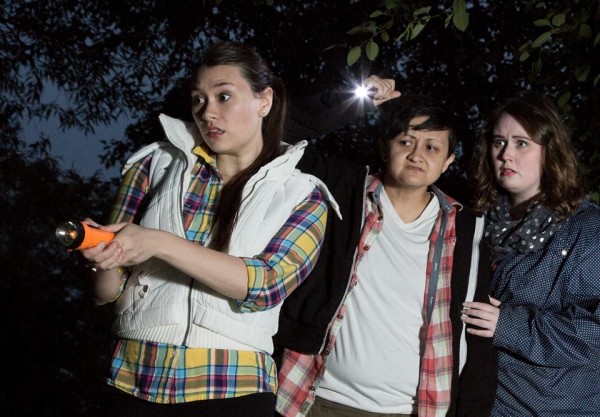
Zenaida Smith, Jordi Montes and Alysha Curry investigate “something nasty” in the woods in Annex Theatre’s THE LOST GIRLS. Photo: Annex Theatre
Review: The Lost Girls by Courtney Meaker. Produced by Annex Theatre. Directed by Kaytlin McIntyre. Fight Choreography by Ryan Higgins. Scenic Design by Jenny Littlefield. Costume Design by Corinne Magin. Props Design by Emma Ambacher. Lighting Design by Gwyn Skone. Sound Design by Erin Bednarz. With Alysha Curry, Rachel Guyer-Mafune, Shermona Mitchell, Jordi Montes, Zenaida Smith, Dayo Vice. Now through November 19, 2016.
But, it’s a big “no” to Annex Theatre’s debut of a new play by Courtney Meaker. While I’ve enjoyed previous works by Ms Meaker at Annex (Chaos Theory from a couple years back had some terrific stuff in it) I’m afraid there’s less to like with her messy new work, THE LOST GIRLS her female empowerment play about some spooky goings on at a girl’s summer camp in the woods. Despite the usual clever DIY design elements we’ve come to expect from Annex and a talented ensemble of female actors, The Lost Girls ultimately fails due to a script that includes just about everything but the kitchen sink.
It’s full of exposition and the cast gathers in the opening scene to present a ton of it in the first few minutes. It’s a complex tale involving a feminist college being shut down during Prohibition because the women were making booze but there were also supernatural forces at work as well and several children from the nearby town “disappeared”. The women at the college were blamed and the townspeople sought revenge. Cut to years later and the college is now a summer camp where it seems nasty things are still going on that may or may not involve the original evil beast as well as the ghosts of the women who were lynched by the angry mob.
Yeah. That’s confusing I know. It’s just as confusing as it unwinds over the course of an overly long two act play that ended up being over two hours long or so (and felt longer…) Despite the fact the modern trend in play writing is to write one act plays of 90 minutes or so, Annex seems to be clinging to traditional formats…but in this case, a major pruning might really help the pacing and story structure of The Lost Girls. It’s far too long and confusing, and frankly it’s not that interesting despite the presence of some fun characters and snappy dialogue. And, while the play is to be admired for providing strong roles for its all female cast and for an overall message of female empowerment (and very specific lesbian empowerment as well since many of the characters are lesbian and not shy about expressing themselves in this play!), it ultimately fails due to its messy plotting.
The cast is quite strong and the all female design team is also on point with a terrific spooky set design from Jenny Littlefield and equally fun spooky lighting and sound designs from Gwyn Skone and Erin Bednarz respectively.
As is frequently the case with Annex shows, this is another example of an Annex play that might work better as a cheap midnight horror flick…but, even then, it could use some rewriting. With that, it could be a fun sleeper hit…the world DOES need a campy, feminist empowering, lesbian lusty horror film playing on the LGBTQ film festival circuit. The Lost Girls could fit that bill.


